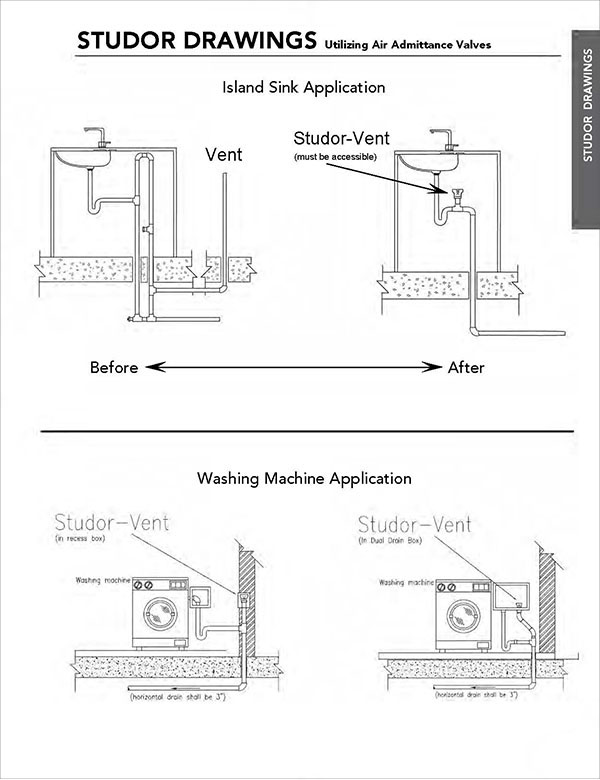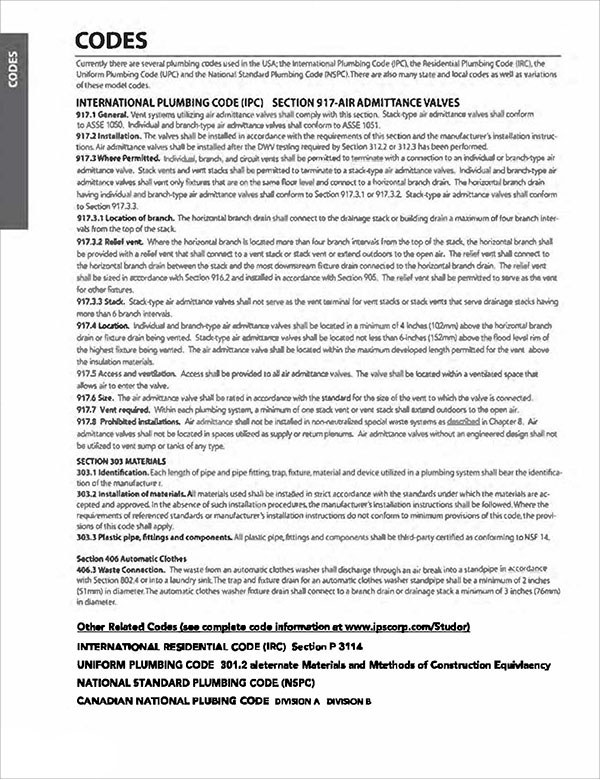
Regulations
Find out about the three main standards
In the world there are three main standards which apply to building installation products: European, Australian and the USA standards. The Studor products have been approved to these standards (as well as other national standards), making them not only a technically advanced solution, but also a regulatory approved product to use. Over the years the Studor technical team has contributed to raising the quality of each standard by supplying credible and scientifically proven information.
Australia and New Zealand Regulations
Australian / New Zealand Standard AS/NZS 4936:2002
AS/NZS 4936:2002, which covers “Air admittance valves (AAVs) for use in sanitary plumbing and drainage systems”, was published in September 2002. It is based on the European Standard EN 12380, but adapted to extend its scope to include AAVs which are integral with the fixture trap (combined traps and AAVs). AS/NZS 4936:2002 provides performance requirements for AAVs suitable for use in plumbing systems designed in accordance with AS/NZS 3500.2.1 and AS/NZS 3500.2.2.
Whereas EN 12380 includes a classification system for AAVs based on their performance, all valves complying with AS/NZS 4936:2002 are suitable for installation below the flood level of the appliance or fixture and are suitable for operation in the temperature range 0°C to 60°C.
The Studor combined traps and AAVs conform to the basic requirements of AS/NZS 4936:2002, but the Studor AAVs exceed the requirements, being AI classified in accordance with EN 12380, meaning that they have been tested and proven to perform down to -20°C.
Australian WATERMARK TECHNICAL SPECIFICATION WMTS463:2015
WMTS463:2015 Watermark Technical Specification for plumbing and drainage products sets out requirements and test methods for devices to attenuate positive pressure transients in plumbing stacks, intended for operation within the temperature range of 0°C to 40°C.
The Studor P.A.P.A. (Positive Air Pressure Attenuator) complies with WMTS463:2015.
The Watermark
In Australia and New Zealand, where the Watermark Standard approval is required in order for products to be legally installed – there is not the same element of trust on the manufacturers as there is with the European standards and the CE mark. The Watermark approval provides independent verification that the products do indeed fully conform and comply with the requirements detailed in the performance standards.
Independent Validation
To comply with the strict Watermark requirements, Studor has sought independent validation for all their products covered by the above standards. These products are regularly tested by independent testing institutes and Studor’s manufacturing facilities are annually inspected by an independent body. These surveillance documents are reviewed by IAPMO, one of the accreditation bodies for the Watermark.
Australian/New Zealand Standard AS/NZS 3500.2:2015
AS/NZS 3500.2:2015 (Plumbing and drainage – Part 2: Sanitary plumbing and drainage) was published in 2015 and supersedes AS/NZS 3500.2:2003. Applying to new installations as well as alterations, additions or repairs to existing installations, the standard specifies the requirements for the design and installation of sanitary plumbing and drainage from the fixtures to a sewer, common effluent system or an on-site wastewater management system, as appropriate.
Table 6.2(A) provides a table detailing the fixture unit ratings for all fixtures, which are to be used for the sizing of drains, stacks and graded discharge pipes. Section 6.9 of the standard provides the guidelines for how AAVs may be used.
Section 6.10 was added as part of the November 2005 amendment, and provides guidelines on how devices to attenuate positive pressure transients in plumbing stacks, i.e. the P.A.P.A. (Positive Air Pressure Attenuator), may be used.
USA and Canadian regulations
Studor adheres to the following USA and Canadian regulations and plumbing codes:
- International Plumbing Code (IPC).
- International Residential Code (IRC).
- Uniform Plumbing Code (UPC).
- National Standard Plumbing Code (NSPC).
- Canadian National Plumbing.
Europe Regulations and AAVs
European Standard EN 12380:2002
The first European standard (EN 12380:2002) to cover the requirements, test methods and evaluation of conformity for Air Admittance Valves (AAVs) for drainage systems installed within buildings (in accordance with European Standard EN 12056-2:2002) was published in December 2002. Having been instrumental in its development, Studor fully embraced the introduction of the standard, which sets the performance requirements for AAVs and how the manufacturer should demonstrate compliance with the standard.
Classification
Contained within EN 12380:2002 is a table (see below) which classifies AAVs based on their performance – AI is the highest classification and BIII is the lowest classification.
The Studor AAVs are AI classified, which means that they may be installed in extreme temperatures and below the flood level of the appliance.
The Studor combined traps and AAVs are AII classified, which means that they may be installed in temperatures ranging from 0°C to +60°C and below the flood level of the appliance.
There are a number of AAVs on the market with varying performances. This classification is essential to differentiate between them.
| Determining Factor | Range/Position |
Designation |
Permitted to be located below flood level of connected appliances |
YES | A |
| NO | B | |
Temperature |
-20°C
0°C 0°C
to
to to
+60°C
+60°C +20°C |
I II III |
The CE mark
The CE mark applied to a product is a self-certification by the manufacturer that the product fulfils the essential requirements of the relevant European standard. In most cases there is no requirement for independent validation of certification, which puts an element of trust on the manufacturer to make a truthful declaration.
Independent Validation
Studor has sought independent validation for their core products to verify the right to apply the CE mark and prove conformance to EN 12380:2002. These products are tested every two years by an independent testing institute and Studor’s manufacturing facilities are inspected annually by an independent body. These surveillance documents are reviewed by DIN CERTCO who has issued the KEYMARK to Studor for the Mini-Vent and Maxi-Vent.
The KEYMARK
The KEYMARK is a European quality mark and product certification scheme issued by the European Standard Organisation CEN (similar to the Kitemark issued in the UK by the BSI) and empowered by DIN CERTCO – the certification organisation of DIN, the German Institute for Standardisation. It proves that the Studor products fully comply with EN 12380:2002 through DIN CERTCO’s independent auditing and further reinforces the emphasis Studor places on quality, which fits in line with their mission statement to be the best quality product in the market place.
Relevance of the KEYMARK outside of Europe
As a European-wide accepted mark of quality with third-party validation, the KEYMARK is again of high importance for the international market. Some countries have already started to adopt European standards such as EN 12380:2002 as adequate replacement or guidance for their own national standards.
EUROPEAN STANDARD EN 12056-2:2002
EN 12056-2:2002 (Gravity drainage systems inside buildings – Part 2: Sanitary pipework, layout and calculation) was published in June 2000. It sets out the principles to be followed for layout and calculation for waste water drainage systems which operate under gravity.
The standard provides different options for handling primary and secondary ventilation and, for the first time within a standard, it specifies AAVs as a legal alternative to the traditional pipe ventilation. Guidelines for the use of AAVs are detailed, including the requirement for them to comply with EN 12380.
EN 12056-2 provides a table based on the fixture units within the drainage system in order to calculate the required airflow. Studor developed the Airflow Calculator as a valuable tool to simplify the calculation process.
If you require any assistance designing your drainage system please contact our technical support team.
PO Box 970 Parramatta NSW 2524
Australia
Tel. 1300 551 519
[email protected]

